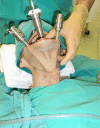Transoral robotic thyroid surgery
- PMID: 26425456
- PMCID: PMC4561656
- DOI: 10.3978/j.issn.2227-684X.2015.02.02
Transoral robotic thyroid surgery
Abstract
There is currently significant demand for minimally invasive thyroid surgery; however the majority of proposed surgical approaches necessitate a compromise between minimal tissue dissection with a visible cervical scar or extensive tissue dissection with a remote, hidden scar. The development of transoral endoscopic thyroid surgery however provides an approach which is truly minimally invasive, as it conceals the incision within the oral cavity without significantly increasing the amount of required dissection. The transoral endoscopic approach however presents multiple technical challenges, which could be overcome with the incorporation of a robotic operating system. This manuscript summarizes the literature on the feasibility and current clinical experience with transoral robotic thyroid surgery.
Keywords: Transoral; endoscopic; minimally invasive; robotic; thyroid surgery; thyroidectomy.
Conflict of interest statement
Figures







References
-
- Becker AM, Gourin CG. New technologies in thyroid surgery. Surg Oncol Clin N Am 2008;17:233-48, x. - PubMed
-
- Davies L, Welch HG. Current thyroid cancer trends in the United States. JAMA Otolaryngol Head Neck Surg 2014;140:317-22. - PubMed
-
- Richmon JD, Pattani KM, Benhidjeb T, et al. Transoral robotic-assisted thyroidectomy: a preclinical feasibility study in 2 cadavers. Head Neck 2011;33:330-3. - PubMed
-
- Benhidjeb T, Wilhelm T, Harlaar J, et al. Natural orifice surgery on thyroid gland: totally transoral video-assisted thyroidectomy (TOVAT): report of first experimental results of a new surgical method. Surg Endosc 2009;23:1119-20. - PubMed
Publication types
LinkOut - more resources
Full Text Sources
